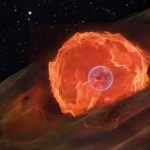Key Takeaways:
- The collision of two black holes has provided experimental confirmation of Stephen Hawking’s Area Theorem, which states that the area of a black hole’s event horizon cannot shrink.
- As a binary black hole system inspirals, emitting gravitational waves, the orbits of the black holes shrink until they merge into a single, new black hole.
- Hawking’s Theorem holds true for the black holes observed by the Laser Interferometer Gravitational-Wave Observatory (LIGO), and it could potentially apply to other black holes as well.
- Hawking radiation, a concept proposed by Stephen Hawking in 1974, suggests that black holes can emit electromagnetic radiation and potentially shrink over time.
- This confirmation provides a significant step forward in our understanding of black holes and creates a stronger connection between theoretical astrophysics and experimental observations.
In a groundbreaking observation, scientists from the Massachusetts Institute of Technology (MIT), California Institute of Technology, Cornell University, and Stony Brook University have validated a 50-year-old theorem by Stephen Hawking through the analysis of gravitational wave data from two merging black holes. The theorem, known as Hawking’s Area Theorem, asserts that the event horizon of a black hole cannot decrease in size.
When a pair of black holes orbit each other, they emit gravitational waves, with the emission rate increasing as the orbits shrink. Ultimately, they merge into a single, new black hole. According to Hawking’s theorem, the area of this new black hole should be equivalent to the combined area of the original two. This aligns precisely with the data obtained from the observed inspiraling system.
Riccardo Penco, an assistant Professor of High Energy Physics Theory at Carnegie Mellon University, notes that this confirmation brings us closer to comprehending the intricacies of black hole dynamics. The detection of gravitational waves allows for direct testing of black holes, as opposed to indirect methods involving the study of surrounding objects. Penco emphasizes that we are now equipped to experimentally verify the properties that were previously studied purely as mathematical concepts.
Hawking’s calculations propose that changes in a black hole’s area correspond to alterations in the size of its event horizon—the region influencing a black hole’s gravitational field. This boundary signifies the point beyond which escape, even for light, becomes impossible without surpassing the speed of light.
Furthermore, Hawking’s Theorem has been found to apply not only to the black holes observed by the Laser Interferometer Gravitational-Wave Observatory (LIGO) but could potentially extend to other types of black holes. An exception to the theorem, known as Hawking radiation, was also postulated by Hawking. This theory suggests that black holes can emit electromagnetic radiation, potentially leading to a reduction in their mass and size over time.
The study, which detected the first gravitational wave signal from two merging black holes in 2015, involved a meticulous analysis of pre- and post-merger wave data. The results showed that the event horizon area of the newly formed black hole remained consistent with the total area of its parent black holes, in line with Hawking’s Area Theorem.
This milestone affirms that established principles of physics, such as the conservation of mass, apply to the study of black holes, even in scenarios that deviate from our everyday experiences.
By leveraging real-world data to probe the laws governing black hole behavior, scientists are advancing the field of cosmology. While this confirmation reinforces our understanding of black holes, it also forges a critical link between tangible scientific experimentation and the theoretical realm of space exploration.


